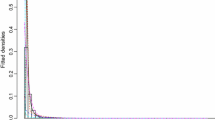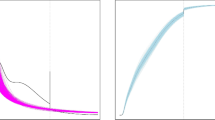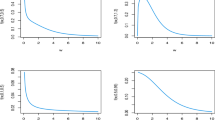Abstract
This paper introduces a new class of distributions, named length-biased Weibull mixtures, in order to deal with heavy-tailed data encountered in quantitative risk modeling. As a generalization of the Erlang mixtures with common scale parameter, our proposed class possesses attractive modeling features such as flexibility to fit various distributional shapes and weak denseness in the class of distributions for all positive random variables. In particular, the asymptotic result shows that the length-biased Weibull mixture behaves like a Weibull-tail distribution, making it more appropriate to model heavy-tailed loss severity data. A method of statistical estimation using EM algorithm is discussed, and then applied to a simulated data set and real catastrophic losses for illustration.



Similar content being viewed by others
Notes
Details on the database can be found at http://www.icadataglobe.com/access-catastrophe-data/.
References
Bae, T., & Chen, J. (2017). On heavy-tailed crack distribution for loss severity modeling. International Journal of Statistics and Probability, 6, 92–110.
Birnbaum, Z. W., & Saunders, S. C. (1969a). Estimation for a family of life distributions with applications to fatigue. Journal of Applied Probability, 6, 328–347.
Birnbaum, Z. W., & Saunders, S. C. (1969b). A new family of life distributions. Journal of Applied Probability, 6, 319–327.
Chaudhury, M. (2010). A review of the key issues in operational risk capital modeling. The Journal of Operational Risk, 5(3), 37–66.
Dempster, A., Laird, N., & Rubin, D. (1977). Maximum likelihood from incomplete data via the EM algorithm. Journal of the Royal Statistical Society Series B (Methodological), 39, 1–38.
Embrechts, P., Maejima, M., & Teugels, J. (1985). Asymptotic behaviour of compound distributions. ASTIN Bulletin, 15, 45–48.
Gupta, R., & Kirmani, S. N. V. A. (1990). The role of weighted distribution in stochastic modeling. Communications in Statistics-Theory and Methods, 19, 3147–3162.
Jacquet, P., & Szpankowski, W. (1996). Analytical Depoissonization and its Applications.. Technical Report 96-062 Purdue University.
Karlis, D., & Xekalaki, E. (2003). Choosing initial values for the EM algorithm for finite mixtures. Computational Statistics & Data Analysis, 41, 577–590.
Klüppelberg, C., & Villaseñor, J. (1993). Estimation of distribution tails—A semiparametric approach. Blätter DGVFM, 21, 213–235.
Lee, S., & Lin, X. (2010). Modeling and evaluating insurance losses via mixtures of Erlang distributions. North American Actuarial Journal, 14, 107–130.
Leiva, V., Sanhueza, A., Kotz, S., & Araneda, N. (2010). A unified mixture model based on the inverse Gaussian distribution. Pakistan Journal of Statistics, 26, 445–460.
Pitman, E. (1980). Subexponential distribution functions. Journal of the Australian Mathematical Society (Series A), 29, 337–347.
Stacy, E. (1962). A generalization of the gamma distribution. The Annals of Mathematical Statistics, 33, 1187–1192.
Su, C., & Tang, Q. (2003). Characterizations on heavy-tailed distributions by means of hazard rate. Acta Mathematicae Applicatae Sinica, 19, 135–142.
Verbelen, R., Gong, L., Antonio, K., Badescu, A., & Lin, S. (2015). Fitting mixtures of Erlangs to censored and truncated data using the EM algorithm. ASTIN Bulletin, 45, 729–758.
Volodin, I., & Dzhungurova, O. (2000). On limit distributions emerging in the generalized Birnbaum–Saunders model. Journal of Mathematical Sciences, 99, 1348–1366.
Willmot, G., & Lin, X. (2011). Risk modelling with the mixed Erlang distribution. Applied Stochastic Models in Business and Industry, 27, 2–16.
Acknowledgements
We are grateful to the anonymous reviewers for valuable comments and suggestions. T. Bae is grateful for the support by the Discovery Grant from the Natural Sciences and Engineering Research Council of Canada (Grant Number RGPIN-418195-2013).
Author information
Authors and Affiliations
Corresponding author
Additional information
Publisher's Note
Springer Nature remains neutral with regard to jurisdictional claims in published maps and institutional affiliations.
Rights and permissions
About this article
Cite this article
Bae, T., Ko, B. On the mixtures of length-biased Weibull distributions for loss severity modeling. J. Korean Stat. Soc. 49, 422–438 (2020). https://doi.org/10.1007/s42952-019-00021-z
Received:
Accepted:
Published:
Issue Date:
DOI: https://doi.org/10.1007/s42952-019-00021-z




